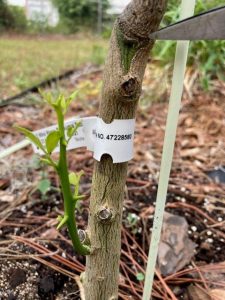I recall one of the first times mama visited the farm. It was a cool, overcast November. Despite the wind and drizzling rain, mama insisted on picking tangerines. We quickly picked a bagful and went inside to enjoy our harvest. The thin rind yielded easily, revealing sweet juicy sections. We enjoyed those citrus and in the ensuing fifteen years the tree continues to produce.
Reputable nurseries sell cold hardy rootstock grafted with cold tolerant scion. Citrus varieties may thrive if your North Florida site does not regularly experience freezing temperature (Rouse and Zekri, 2015). Look for: ‘Hamlin’ or ‘ Valencia’ sweet orange, ‘Redblush’ or Flame’ grapefruit, ‘Mineola’ and satsuma mandarins, ‘Meyer’ lemon, kumquats and calamondin. Like many plants in the landscape, weed control, irrigation management and recommended fertilization routines are needed for fruit production.

In this example, soil test report indicates Phosphorus (P) is interpreted as High. Potassium (K) level interpreted as Low and available Magnesium (Mg) and Calcium (Ca) interpreted as adequate. Adding fertilizer with P and Mg would not be beneficial and may be environmentally damaging because this sample has high levels of each. Look for products with similar Nitrogen (N) and K, like 10-0-10, 8-0-8 or 6-0-6.
Without benefit of soil test report, a complete fertilizer with similar % of N,P and K is sufficient.
Key takeaway:

- Apply fertilizer in split applications between February and October. See Table 2, Citrus Culture in the Home Landscape (Rouse and Zekri, 2015).
- Optimum pH range is 5.5 to 6.5. To determine pH and plant available nutrients, use Test B. Standard soil fertility, crop code #62. Download Landscape and Vegetable Garden test form from UF/IFAS Extension Soil Testing Laboratory.
- Plant root ball 1-2 inches above grade in sandy, well drained soils.
- Do not plant within thirty feet of drain field.
- Some citrus requires a pollenizer for good fruit set. ‘Temple’ or Sunburst are examples of pollenizers.
- Mulching around citrus is not recommended.
- Remove sprouts that arise below the graft. These are from rootstock and will not produce desirable fruit.
Chapter 17. Planting and Establishing Trees (Gilman and Patterson, 2017), summarizes planting trees in sandy well drained soils and irrigation requirements. Did you find this post helpful? Click the heart below. Until next time good luck with your citrus. Let me know how it grows and Happy Gardening!
 1
1
